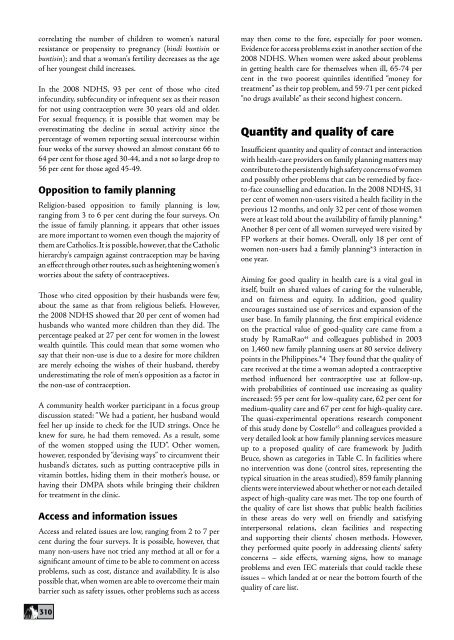Family Planning in Asia and the Pacific - International Council on ...
Family Planning in Asia and the Pacific - International Council on ...
Family Planning in Asia and the Pacific - International Council on ...
You also want an ePaper? Increase the reach of your titles
YUMPU automatically turns print PDFs into web optimized ePapers that Google loves.
correlat<str<strong>on</strong>g>in</str<strong>on</strong>g>g <str<strong>on</strong>g>the</str<strong>on</strong>g> number of children to women's naturalresistance or propensity to pregnancy (h<str<strong>on</strong>g>in</str<strong>on</strong>g>di buntis<str<strong>on</strong>g>in</str<strong>on</strong>g> orbuntis<str<strong>on</strong>g>in</str<strong>on</strong>g>); <str<strong>on</strong>g>and</str<strong>on</strong>g> that a woman's fertility decreases as <str<strong>on</strong>g>the</str<strong>on</strong>g> ageof her youngest child <str<strong>on</strong>g>in</str<strong>on</strong>g>creases.In <str<strong>on</strong>g>the</str<strong>on</strong>g> 2008 NDHS, 93 per cent of those who cited<str<strong>on</strong>g>in</str<strong>on</strong>g>fecundity, subfecundity or <str<strong>on</strong>g>in</str<strong>on</strong>g>frequent sex as <str<strong>on</strong>g>the</str<strong>on</strong>g>ir reas<strong>on</strong>for not us<str<strong>on</strong>g>in</str<strong>on</strong>g>g c<strong>on</strong>tracepti<strong>on</strong> were 30 years old <str<strong>on</strong>g>and</str<strong>on</strong>g> older.For sexual frequency, it is possible that women may beoverestimat<str<strong>on</strong>g>in</str<strong>on</strong>g>g <str<strong>on</strong>g>the</str<strong>on</strong>g> decl<str<strong>on</strong>g>in</str<strong>on</strong>g>e <str<strong>on</strong>g>in</str<strong>on</strong>g> sexual activity s<str<strong>on</strong>g>in</str<strong>on</strong>g>ce <str<strong>on</strong>g>the</str<strong>on</strong>g>percentage of women report<str<strong>on</strong>g>in</str<strong>on</strong>g>g sexual <str<strong>on</strong>g>in</str<strong>on</strong>g>tercourse with<str<strong>on</strong>g>in</str<strong>on</strong>g>four weeks of <str<strong>on</strong>g>the</str<strong>on</strong>g> survey showed an almost c<strong>on</strong>stant 66 to64 per cent for those aged 30-44, <str<strong>on</strong>g>and</str<strong>on</strong>g> a not so large drop to56 per cent for those aged 45-49.Oppositi<strong>on</strong> to family plann<str<strong>on</strong>g>in</str<strong>on</strong>g>gReligi<strong>on</strong>-based oppositi<strong>on</strong> to family plann<str<strong>on</strong>g>in</str<strong>on</strong>g>g is low,rang<str<strong>on</strong>g>in</str<strong>on</strong>g>g from 3 to 6 per cent dur<str<strong>on</strong>g>in</str<strong>on</strong>g>g <str<strong>on</strong>g>the</str<strong>on</strong>g> four surveys. On<str<strong>on</strong>g>the</str<strong>on</strong>g> issue of family plann<str<strong>on</strong>g>in</str<strong>on</strong>g>g, it appears that o<str<strong>on</strong>g>the</str<strong>on</strong>g>r issuesare more important to women even though <str<strong>on</strong>g>the</str<strong>on</strong>g> majority of<str<strong>on</strong>g>the</str<strong>on</strong>g>m are Catholics. It is possible, however, that <str<strong>on</strong>g>the</str<strong>on</strong>g> Catholichierarchy's campaign aga<str<strong>on</strong>g>in</str<strong>on</strong>g>st c<strong>on</strong>tracepti<strong>on</strong> may be hav<str<strong>on</strong>g>in</str<strong>on</strong>g>gan effect through o<str<strong>on</strong>g>the</str<strong>on</strong>g>r routes, such as heighten<str<strong>on</strong>g>in</str<strong>on</strong>g>g women'sworries about <str<strong>on</strong>g>the</str<strong>on</strong>g> safety of c<strong>on</strong>traceptives.Those who cited oppositi<strong>on</strong> by <str<strong>on</strong>g>the</str<strong>on</strong>g>ir husb<str<strong>on</strong>g>and</str<strong>on</strong>g>s were few,about <str<strong>on</strong>g>the</str<strong>on</strong>g> same as that from religious beliefs. However,<str<strong>on</strong>g>the</str<strong>on</strong>g> 2008 NDHS showed that 20 per cent of women hadhusb<str<strong>on</strong>g>and</str<strong>on</strong>g>s who wanted more children than <str<strong>on</strong>g>the</str<strong>on</strong>g>y did. Thepercentage peaked at 27 per cent for women <str<strong>on</strong>g>in</str<strong>on</strong>g> <str<strong>on</strong>g>the</str<strong>on</strong>g> lowestwealth qu<str<strong>on</strong>g>in</str<strong>on</strong>g>tile. This could mean that some women whosay that <str<strong>on</strong>g>the</str<strong>on</strong>g>ir n<strong>on</strong>-use is due to a desire for more childrenare merely echo<str<strong>on</strong>g>in</str<strong>on</strong>g>g <str<strong>on</strong>g>the</str<strong>on</strong>g> wishes of <str<strong>on</strong>g>the</str<strong>on</strong>g>ir husb<str<strong>on</strong>g>and</str<strong>on</strong>g>, <str<strong>on</strong>g>the</str<strong>on</strong>g>rebyunderestimat<str<strong>on</strong>g>in</str<strong>on</strong>g>g <str<strong>on</strong>g>the</str<strong>on</strong>g> role of men's oppositi<strong>on</strong> as a factor <str<strong>on</strong>g>in</str<strong>on</strong>g><str<strong>on</strong>g>the</str<strong>on</strong>g> n<strong>on</strong>-use of c<strong>on</strong>tracepti<strong>on</strong>.A community health worker participant <str<strong>on</strong>g>in</str<strong>on</strong>g> a focus groupdiscussi<strong>on</strong> stated: “We had a patient, her husb<str<strong>on</strong>g>and</str<strong>on</strong>g> wouldfeel her up <str<strong>on</strong>g>in</str<strong>on</strong>g>side to check for <str<strong>on</strong>g>the</str<strong>on</strong>g> IUD str<str<strong>on</strong>g>in</str<strong>on</strong>g>gs. Once heknew for sure, he had <str<strong>on</strong>g>the</str<strong>on</strong>g>m removed. As a result, someof <str<strong>on</strong>g>the</str<strong>on</strong>g> women stopped us<str<strong>on</strong>g>in</str<strong>on</strong>g>g <str<strong>on</strong>g>the</str<strong>on</strong>g> IUD”. O<str<strong>on</strong>g>the</str<strong>on</strong>g>r women,however, resp<strong>on</strong>ded by “devis<str<strong>on</strong>g>in</str<strong>on</strong>g>g ways” to circumvent <str<strong>on</strong>g>the</str<strong>on</strong>g>irhusb<str<strong>on</strong>g>and</str<strong>on</strong>g>’s dictates, such as putt<str<strong>on</strong>g>in</str<strong>on</strong>g>g c<strong>on</strong>traceptive pills <str<strong>on</strong>g>in</str<strong>on</strong>g>vitam<str<strong>on</strong>g>in</str<strong>on</strong>g> bottles, hid<str<strong>on</strong>g>in</str<strong>on</strong>g>g <str<strong>on</strong>g>the</str<strong>on</strong>g>m <str<strong>on</strong>g>in</str<strong>on</strong>g> <str<strong>on</strong>g>the</str<strong>on</strong>g>ir mo<str<strong>on</strong>g>the</str<strong>on</strong>g>r’s house, orhav<str<strong>on</strong>g>in</str<strong>on</strong>g>g <str<strong>on</strong>g>the</str<strong>on</strong>g>ir DMPA shots while br<str<strong>on</strong>g>in</str<strong>on</strong>g>g<str<strong>on</strong>g>in</str<strong>on</strong>g>g <str<strong>on</strong>g>the</str<strong>on</strong>g>ir childrenfor treatment <str<strong>on</strong>g>in</str<strong>on</strong>g> <str<strong>on</strong>g>the</str<strong>on</strong>g> cl<str<strong>on</strong>g>in</str<strong>on</strong>g>ic.Access <str<strong>on</strong>g>and</str<strong>on</strong>g> <str<strong>on</strong>g>in</str<strong>on</strong>g>formati<strong>on</strong> issuesAccess <str<strong>on</strong>g>and</str<strong>on</strong>g> related issues are low, rang<str<strong>on</strong>g>in</str<strong>on</strong>g>g from 2 to 7 percent dur<str<strong>on</strong>g>in</str<strong>on</strong>g>g <str<strong>on</strong>g>the</str<strong>on</strong>g> four surveys. It is possible, however, thatmany n<strong>on</strong>-users have not tried any method at all or for asignificant amount of time to be able to comment <strong>on</strong> accessproblems, such as cost, distance <str<strong>on</strong>g>and</str<strong>on</strong>g> availability. It is alsopossible that, when women are able to overcome <str<strong>on</strong>g>the</str<strong>on</strong>g>ir ma<str<strong>on</strong>g>in</str<strong>on</strong>g>barrier such as safety issues, o<str<strong>on</strong>g>the</str<strong>on</strong>g>r problems such as accessmay <str<strong>on</strong>g>the</str<strong>on</strong>g>n come to <str<strong>on</strong>g>the</str<strong>on</strong>g> fore, especially for poor women.Evidence for access problems exist <str<strong>on</strong>g>in</str<strong>on</strong>g> ano<str<strong>on</strong>g>the</str<strong>on</strong>g>r secti<strong>on</strong> of <str<strong>on</strong>g>the</str<strong>on</strong>g>2008 NDHS. When women were asked about problems<str<strong>on</strong>g>in</str<strong>on</strong>g> gett<str<strong>on</strong>g>in</str<strong>on</strong>g>g health care for <str<strong>on</strong>g>the</str<strong>on</strong>g>mselves when ill, 65-74 percent <str<strong>on</strong>g>in</str<strong>on</strong>g> <str<strong>on</strong>g>the</str<strong>on</strong>g> two poorest qu<str<strong>on</strong>g>in</str<strong>on</strong>g>tiles identified “m<strong>on</strong>ey fortreatment” as <str<strong>on</strong>g>the</str<strong>on</strong>g>ir top problem, <str<strong>on</strong>g>and</str<strong>on</strong>g> 59-71 per cent picked“no drugs available” as <str<strong>on</strong>g>the</str<strong>on</strong>g>ir sec<strong>on</strong>d highest c<strong>on</strong>cern.Quantity <str<strong>on</strong>g>and</str<strong>on</strong>g> quality of careInsufficient quantity <str<strong>on</strong>g>and</str<strong>on</strong>g> quality of c<strong>on</strong>tact <str<strong>on</strong>g>and</str<strong>on</strong>g> <str<strong>on</strong>g>in</str<strong>on</strong>g>teracti<strong>on</strong>with health-care providers <strong>on</strong> family plann<str<strong>on</strong>g>in</str<strong>on</strong>g>g matters mayc<strong>on</strong>tribute to <str<strong>on</strong>g>the</str<strong>on</strong>g> persistently high safety c<strong>on</strong>cerns of women<str<strong>on</strong>g>and</str<strong>on</strong>g> possibly o<str<strong>on</strong>g>the</str<strong>on</strong>g>r problems that can be remedied by faceto-facecounsell<str<strong>on</strong>g>in</str<strong>on</strong>g>g <str<strong>on</strong>g>and</str<strong>on</strong>g> educati<strong>on</strong>. In <str<strong>on</strong>g>the</str<strong>on</strong>g> 2008 NDHS, 31per cent of women n<strong>on</strong>-users visited a health facility <str<strong>on</strong>g>in</str<strong>on</strong>g> <str<strong>on</strong>g>the</str<strong>on</strong>g>previous 12 m<strong>on</strong>ths, <str<strong>on</strong>g>and</str<strong>on</strong>g> <strong>on</strong>ly 32 per cent of those womenwere at least told about <str<strong>on</strong>g>the</str<strong>on</strong>g> availability of family plann<str<strong>on</strong>g>in</str<strong>on</strong>g>g.*Ano<str<strong>on</strong>g>the</str<strong>on</strong>g>r 8 per cent of all women surveyed were visited byFP workers at <str<strong>on</strong>g>the</str<strong>on</strong>g>ir homes. Overall, <strong>on</strong>ly 18 per cent ofwomen n<strong>on</strong>-users had a family plann<str<strong>on</strong>g>in</str<strong>on</strong>g>g*3 <str<strong>on</strong>g>in</str<strong>on</strong>g>teracti<strong>on</strong> <str<strong>on</strong>g>in</str<strong>on</strong>g><strong>on</strong>e year.Aim<str<strong>on</strong>g>in</str<strong>on</strong>g>g for good quality <str<strong>on</strong>g>in</str<strong>on</strong>g> health care is a vital goal <str<strong>on</strong>g>in</str<strong>on</strong>g>itself, built <strong>on</strong> shared values of car<str<strong>on</strong>g>in</str<strong>on</strong>g>g for <str<strong>on</strong>g>the</str<strong>on</strong>g> vulnerable,<str<strong>on</strong>g>and</str<strong>on</strong>g> <strong>on</strong> fairness <str<strong>on</strong>g>and</str<strong>on</strong>g> equity. In additi<strong>on</strong>, good qualityencourages susta<str<strong>on</strong>g>in</str<strong>on</strong>g>ed use of services <str<strong>on</strong>g>and</str<strong>on</strong>g> expansi<strong>on</strong> of <str<strong>on</strong>g>the</str<strong>on</strong>g>user base. In family plann<str<strong>on</strong>g>in</str<strong>on</strong>g>g, <str<strong>on</strong>g>the</str<strong>on</strong>g> first empirical evidence<strong>on</strong> <str<strong>on</strong>g>the</str<strong>on</strong>g> practical value of good-quality care came from astudy by RamaRao 44 <str<strong>on</strong>g>and</str<strong>on</strong>g> colleagues published <str<strong>on</strong>g>in</str<strong>on</strong>g> 2003<strong>on</strong> 1,460 new family plann<str<strong>on</strong>g>in</str<strong>on</strong>g>g users at 80 service deliverypo<str<strong>on</strong>g>in</str<strong>on</strong>g>ts <str<strong>on</strong>g>in</str<strong>on</strong>g> <str<strong>on</strong>g>the</str<strong>on</strong>g> Philipp<str<strong>on</strong>g>in</str<strong>on</strong>g>es.*4 They found that <str<strong>on</strong>g>the</str<strong>on</strong>g> quality ofcare received at <str<strong>on</strong>g>the</str<strong>on</strong>g> time a woman adopted a c<strong>on</strong>traceptivemethod <str<strong>on</strong>g>in</str<strong>on</strong>g>fluenced her c<strong>on</strong>traceptive use at follow-up,with probabilities of c<strong>on</strong>t<str<strong>on</strong>g>in</str<strong>on</strong>g>ued use <str<strong>on</strong>g>in</str<strong>on</strong>g>creas<str<strong>on</strong>g>in</str<strong>on</strong>g>g as quality<str<strong>on</strong>g>in</str<strong>on</strong>g>creased: 55 per cent for low-quality care, 62 per cent formedium-quality care <str<strong>on</strong>g>and</str<strong>on</strong>g> 67 per cent for high-quality care.The quasi-experimental operati<strong>on</strong>s research comp<strong>on</strong>entof this study d<strong>on</strong>e by Costello 45 <str<strong>on</strong>g>and</str<strong>on</strong>g> colleagues provided avery detailed look at how family plann<str<strong>on</strong>g>in</str<strong>on</strong>g>g services measureup to a proposed quality of care framework by JudithBruce, shown as categories <str<strong>on</strong>g>in</str<strong>on</strong>g> Table C. In facilities whereno <str<strong>on</strong>g>in</str<strong>on</strong>g>terventi<strong>on</strong> was d<strong>on</strong>e (c<strong>on</strong>trol sites, represent<str<strong>on</strong>g>in</str<strong>on</strong>g>g <str<strong>on</strong>g>the</str<strong>on</strong>g>typical situati<strong>on</strong> <str<strong>on</strong>g>in</str<strong>on</strong>g> <str<strong>on</strong>g>the</str<strong>on</strong>g> areas studied), 859 family plann<str<strong>on</strong>g>in</str<strong>on</strong>g>gclients were <str<strong>on</strong>g>in</str<strong>on</strong>g>terviewed about whe<str<strong>on</strong>g>the</str<strong>on</strong>g>r or not each detailedaspect of high-quality care was met. The top <strong>on</strong>e fourth of<str<strong>on</strong>g>the</str<strong>on</strong>g> quality of care list shows that public health facilities<str<strong>on</strong>g>in</str<strong>on</strong>g> <str<strong>on</strong>g>the</str<strong>on</strong>g>se areas do very well <strong>on</strong> friendly <str<strong>on</strong>g>and</str<strong>on</strong>g> satisfy<str<strong>on</strong>g>in</str<strong>on</strong>g>g<str<strong>on</strong>g>in</str<strong>on</strong>g>terpers<strong>on</strong>al relati<strong>on</strong>s, clean facilities <str<strong>on</strong>g>and</str<strong>on</strong>g> respect<str<strong>on</strong>g>in</str<strong>on</strong>g>g<str<strong>on</strong>g>and</str<strong>on</strong>g> support<str<strong>on</strong>g>in</str<strong>on</strong>g>g <str<strong>on</strong>g>the</str<strong>on</strong>g>ir clients' chosen methods. However,<str<strong>on</strong>g>the</str<strong>on</strong>g>y performed quite poorly <str<strong>on</strong>g>in</str<strong>on</strong>g> address<str<strong>on</strong>g>in</str<strong>on</strong>g>g clients' safetyc<strong>on</strong>cerns – side effects, warn<str<strong>on</strong>g>in</str<strong>on</strong>g>g signs, how to manageproblems <str<strong>on</strong>g>and</str<strong>on</strong>g> even IEC materials that could tackle <str<strong>on</strong>g>the</str<strong>on</strong>g>seissues – which l<str<strong>on</strong>g>and</str<strong>on</strong>g>ed at or near <str<strong>on</strong>g>the</str<strong>on</strong>g> bottom fourth of <str<strong>on</strong>g>the</str<strong>on</strong>g>quality of care list.310














